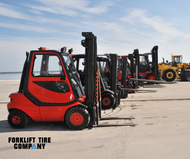23rd Mar 2025
Why Forklift Fleet Management Matters
Managing a fleet of forklifts efficiently is essential for reducing operational costs, minimizing downtime, and improving workplace safety. A well-maintained forklift fleet ensures that your business runs smoothly and avoids unexpected breakdowns that can disrupt productivity. In this guide, we explore the best forklift fleet management strategies to keep your operation running at peak performance.
Maintain Constant Communication
Effective forklift fleet management starts with clear communication among forklift operators, technicians, and supervisors. Keeping an open dialogue ensures that any issues with a forklift are reported and addressed promptly. To streamline communication:
- Define the specific data operators should record, such as forklift usage hours, performance, and maintenance needs.
- Use a centralized system to track real-time forklift performance and safety concerns.
- Encourage operators to report unusual vibrations, performance drops, or mechanical failures immediately.
Classify Your Forklift Fleet
A busy warehouse requires different types of forklifts for different tasks. To improve efficiency, classify your forklift fleet based on:
- Chassis number for easy tracking.
- Tire type to determine terrain suitability.
- Load capacity to ensure proper weight distribution.
- Serial number for quick access to maintenance history.
Proper classification helps simplify maintenance scheduling and makes it easier to source forklift parts when needed.
Schedule Regular Forklift Maintenance
A well-maintained forklift minimizes downtime and extends the lifespan of your equipment. Since forklifts handle heavy lifting daily, wear and tear is inevitable. Follow these maintenance tips:
- Perform daily forklift inspections to check for visible damage, fluid leaks, and tire wear.
- Adhere to manufacturer service intervals to prevent mechanical failures.
- Rotate forklift tires regularly to avoid uneven wear and maintain stability.
- Replace worn-out parts promptly to avoid costly repairs.
Routine maintenance ensures that your forklift fleet remains reliable and safe for operators.
Invest in a Forklift Fleet Management System
A forklift fleet management system helps streamline operations by providing real-time data on each forklift's performance, usage, and maintenance needs. Benefits of using forklift management software include:
1. Forklift Utilization Tracking
A forklift fleet management system provides critical data, such as:
- Operating hours to prevent overuse.
- Idle time analysis to improve efficiency.
- Mileage tracking for optimal maintenance scheduling.
Analyzing this data helps you identify underutilized or overworked forklifts, allowing for better resource allocation.
2. Forklift Safety Reports
Safety is a top priority when managing a forklift fleet. A fleet management system can track:
- Incidents of over-speeding that increase accident risks.
- Operator safety compliance, including seatbelt usage.
- Impact detection to monitor collisions with racks, walls, or other forklifts.
With real-time monitoring, safety risks can be reduced significantly.
3. Forklift Operator Performance Monitoring
Forklift operators play a crucial role in warehouse efficiency. A fleet management system provides data on:
- Operator productivity to ensure adequate work hours.
- History of safety violations to determine training needs.
- Driving habits that impact fuel efficiency and equipment wear.
Monitoring operator performance helps improve forklift handling and workplace safety.
4. Forklift Access Control
Unauthorized use of a forklift increases safety risks and potential equipment damage. A fleet management system can:
- Restrict forklift access to authorized personnel only.
- Assign specific forklifts to trained operators based on experience.
- Track who operates each forklift to ensure accountability.
This prevents unauthorized operation and improves overall forklift fleet safety.
5. Automated Forklift Maintenance Alerts
Since a forklift’s maintenance needs depend on its usage, automated alerts help schedule service at the right time. A fleet management system can:
- Monitor forklift wear and tear based on real-time data.
- Schedule maintenance efficiently to prevent breakdowns.
- Reduce unexpected downtime by addressing issues before they worsen.
With automated tracking, your forklift fleet stays in peak condition with minimal interruptions.
Optimize Warehouse Layout for Forklift Efficiency
A well-planned warehouse layout improves forklift efficiency and reduces travel time. Consider these optimization strategies:
- Minimize long travel distances by positioning forklifts closer to work zones.
- Design wide aisles to prevent bottlenecks and improve forklift maneuverability.
- Use designated forklift lanes to enhance safety and workflow.
A strategic warehouse layout ensures forklifts operate smoothly, boosting productivity and reducing wear.
Conclusion: Improve Your Forklift Fleet Operations Today
Effective forklift fleet management reduces costs, improves efficiency, and enhances workplace safety. To maximize the performance of your forklifts, remember to:
- Maintain constant communication with operators and technicians.
- Classify forklifts to simplify tracking and maintenance.
- Schedule regular maintenance to prevent unexpected breakdowns.
- Invest in a forklift fleet management system for real-time insights.
- Optimize your warehouse layout to improve forklift efficiency.
At Forklift Tire Company, we provide top-quality forklift tires and parts to keep your fleet running smoothly. Visit our online forklift store for the best deals, or contact us at sales@forklifttire.com for expert assistance!






